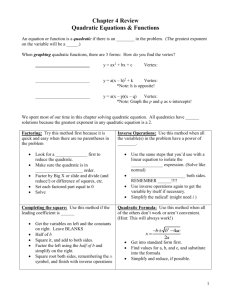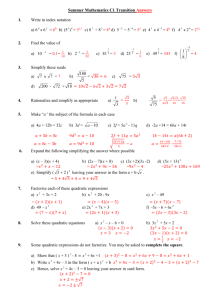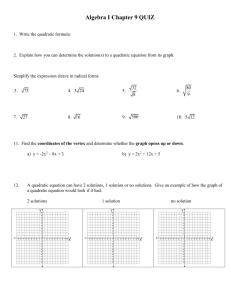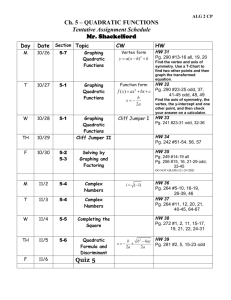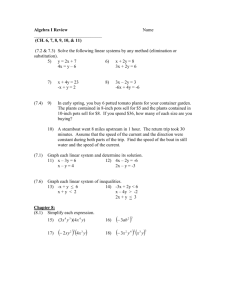Chapter 4 Review Quadratic Equations & Functions
advertisement
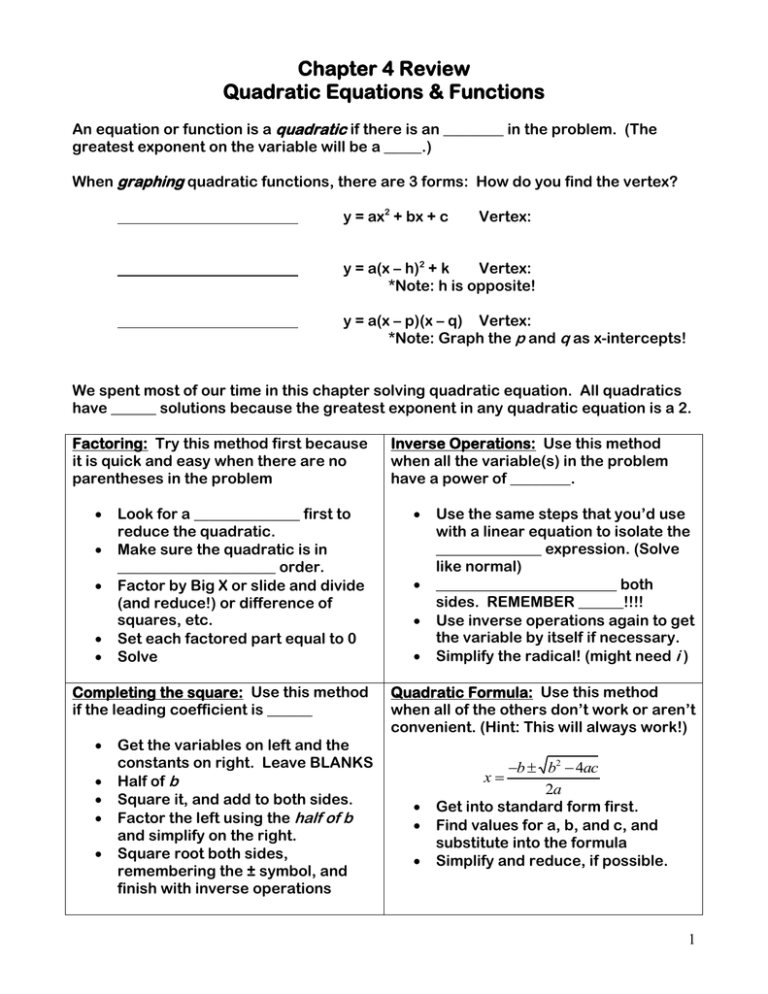
Chapter 4 Review Quadratic Equations & Functions An equation or function is a quadratic if there is an ________ in the problem. (The greatest exponent on the variable will be a _____.) When graphing quadratic functions, there are 3 forms: How do you find the vertex? y = ax2 + bx + c Vertex: y = a(x – h)2 + k Vertex: *Note: h is opposite! y = a(x – p)(x – q) Vertex: *Note: Graph the p and q as x-intercepts! We spent most of our time in this chapter solving quadratic equation. All quadratics have ______ solutions because the greatest exponent in any quadratic equation is a 2. Factoring: Try this method first because it is quick and easy when there are no parentheses in the problem Look for a ______________ first to reduce the quadratic. Make sure the quadratic is in _____________________ order. Factor by Big X or slide and divide (and reduce!) or difference of squares, etc. Set each factored part equal to 0 Solve Completing the square: Use this method if the leading coefficient is ______ Get the variables on left and the constants on right. Leave BLANKS Half of b Square it, and add to both sides. Factor the left using the half of b and simplify on the right. Square root both sides, remembering the ± symbol, and finish with inverse operations Inverse Operations: Use this method when all the variable(s) in the problem have a power of ________. Use the same steps that you’d use with a linear equation to isolate the ______________ expression. (Solve like normal) ________________________ both sides. REMEMBER ______!!!! Use inverse operations again to get the variable by itself if necessary. Simplify the radical! (might need i ) Quadratic Formula: Use this method when all of the others don’t work or aren’t convenient. (Hint: This will always work!) b b2 4ac 2a Get into standard form first. Find values for a, b, and c, and substitute into the formula Simplify and reduce, if possible. x 1 Other things to remember: Complex Numbers 1. No negatives inside a square root – take it out as an i 2. Simplify the remaining square root if possible 3. Use i properties to simplify i 1 i 2 1 i 3 1 4. 5. 6. 7. i4 1 Simplifying i Divide by 4; look at the remainder; no remainder is i4 Multiplying Be sure to simplify i2 = -1 Dividing Multiply by denominator on top and bottom OR by conjugate SIMPLIFY AT END!!! o No radicals or i in denominator! No fractions in radicals! (Separate!) o Simplifying radicals and i if you have 2 terms in denominator: CONJUGATES Extra Textbook Practice for Ch. 4: Pg. 323 Chapter 4 Review Test in book By topic Graphing: pg. 240 #3, 19, 20, 21, 22, 23,35, 36, 39, 40, 41 pg. 249 #3, 5, 11, 13, 15, 18, 22, 25, 27, 33, 34 Solving by Factoring: pg. 256 #25 - 31 odd, 59, 61 pg. 263 #33 - 45 odd, 51, 53, 57, 69 Complex Numbers: pg. 279 #3 - 11 odd, 12 - 16 even, 21, 22 - 32 even, 55 Completing the Square: pg. 288 #4 - 16 even, 19, 23 - 33 odd, 34, 35, 41 - 43, 54 Quadratic Equation: Pg. 296 #3 – 6, 9, 12, 14 – 20 even, 35, 36, 52 – 55, 69, 70 Ch. 4 Review: Pg. 318 #6, 9, 13, 14, 20, 22, 25 – 35 odd, 34, 38 – 41; Pg. 326 #1, 3, 6 – 13, 16, 22 2 PRACTICE! Solve using the most appropriate method. 1. 4x2 – 7 = 3(x2 – 6) 2. 50x2 – 242 = 0 3. 6x2 + 19x + 15 = 0 4. 5x2 + 3 = 4x 6. 2(x + 5)2 – 9 = 39 5. x2 – 14x + 28 = 0 Simplifying: No radicals, real or imaginary, may be in the denominator of a fraction. Also there should be no _____________________factors in the radicand of a square root. Take out all negatives. Separate if needed. 8 5i 8 2 245 9. 7. 8. 1 4i 4 5 6 Graphing: Pay attention to the form when graphing. Use it to help you find some quick, convenient points on the graph. 10. y = -(x – 3)2 11. y = (x + 4)(x – 1) 12. y = x2 – 2x + 3 3 More Practice! 13) Graph each of the following and label the vertex, axis of symmetry, and zeros. a) f (x) 2x3 5 b) g(x) 2x2 6x5 2 c) y 1 x 4 x 2 2 Solve. 1. x2 – 36 = 0 2. x2 + 8x + 16 = 0 3. 3x2 + 7x = -4 4. 14x2 – 21x = 0 5. 9x2 = 100 6. 1 (x 3) 2 7 5 7. x2 – 7 = 29 8. 2x2 + 11 = -37 Simplify. 1 10. 5 6 11. 3 7 2 10 13. (9 – 2i) (-4 + 7i) 14. 12. 18 11 15. 5 1 i 9. 5x2 + 33 = 3 7 5i 1 4i 4
